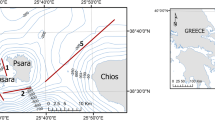Abstract
The composition of the coastal fish fauna around Elephant Island (northern South Shetland Islands) was investigated during seven bottom trawl surveys of FRV “Walther Herwig”, FV “Polarstern” and FRV “Yuzhmorgeologiya” from 1981 to 1998. Low-Antarctic (or lesser or peri-Antarctic) fish species were the predominant element of the coastal fish fauna. Large-scale fishing from 1978 to 1981 reduced stock sizes of the most abundant species Champsocephalus gunnari and Notothenia rossii to the extent that only a small fraction of the initial stock remained. After the period of intensive fishing, Gobionotothen gibberifrons became the most abundant species around the island. The by-catch species, which had probably been less affected by harvesting, recovered by the end of the 1980s/beginning of the 1990s. Fish biomass was highest in the 100- to 400-m depth range. An MDS plot revealed the existence of five groups of species that overlapped in their distribution to some extent. One important factor that separated the five groups was depth. Other factors that might have been important in structuring the vertical distribution of the fish fauna, such as bottom topography and sediment type, could not be investigated. Species composition was dominated by a few abundant low-Antarctic species. In four of the five groups, G. gibberifrons was by far the most abundant species, after C. gunnari and N. rossii had been largely eliminated due to fishing. Only in the 100- to 200-m depth range was C. gunnari more abundant than G. gibberifrons. In the 400- to 500-m depth stratum, a high-Antarctic species, Chionodraco rastrospinosus, and Lepidonotothen squamifrons, a species of Patagonian origin which lacks antifreeze glycopeptides, gained some importance. Species richness showed a positive trend with increasing depth. Evenness and Hill's N1 index were highest in the shallowest and deepest depth strata. Hill's N2 index was lowest in depth strata 3 and 4, which had the most even distribution of the abundant fish species.
Similar content being viewed by others
Author information
Authors and Affiliations
Additional information
Accepted: 21 May 2000
Rights and permissions
About this article
Cite this article
Kock, KH., Stransky, C. The composition of the coastal fish fauna around Elephant Island (South Shetland Islands, Antarctica). Polar Biol 23, 825–832 (2000). https://doi.org/10.1007/s003000000159
Issue Date:
DOI: https://doi.org/10.1007/s003000000159




